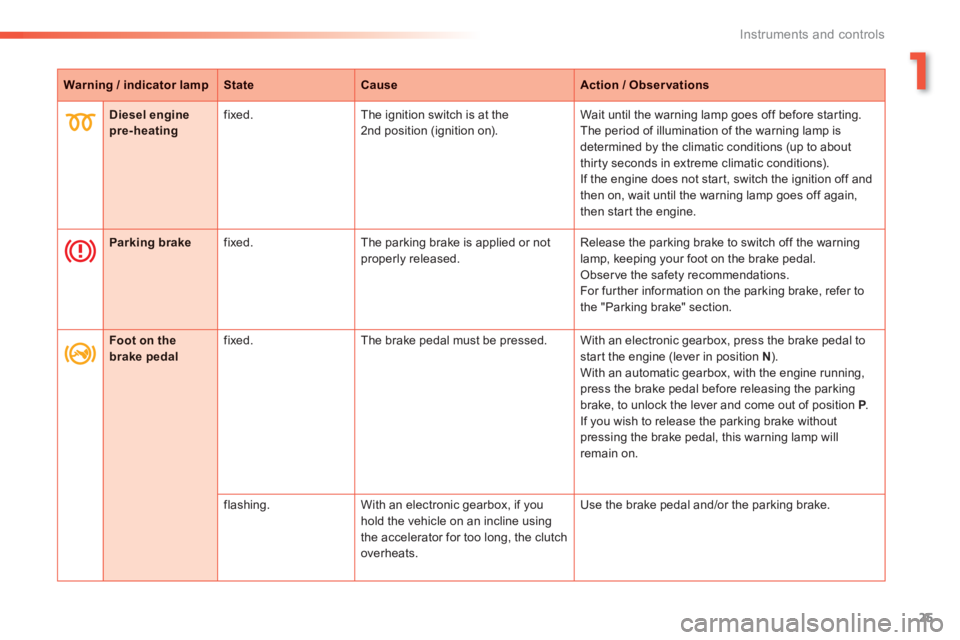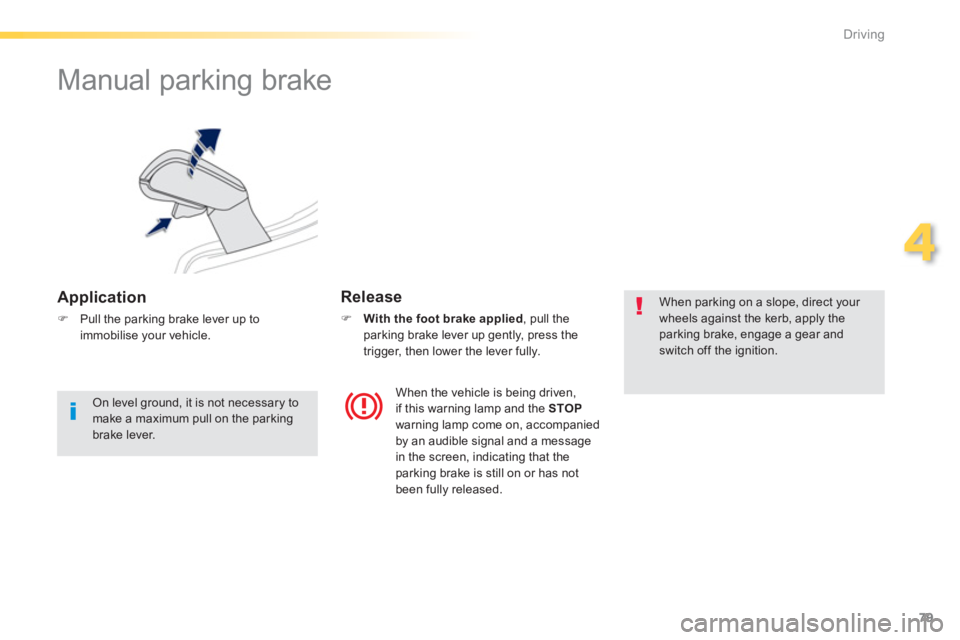2013 PEUGEOT 2008 brake
[x] Cancel search: brakePage 4 of 324

.
.
Contents
Instrument panels 21
Indicator and warning lamps 23
Gauges and indicators 33
Tr i p c o m p u t e r 38
Tr ip computer with touch screen 40
Setting the date and time 43
Instruments and controlsFamiliarisation
Remote control key 44
Alarm 5
1
Electric windows 53
Boot 55
Panoramic sunroof 56
Access
Front seats 57
Rear seats 59
Steering wheel adjustment 60
Mirrors 61
Ventilation 63
Heating 65
Manual air conditioning 65
Dual-zone digital air conditioning 67
Rear screen demist - defrost 70
Interior fi ttings 71
Boot fi ttings 75
Comfort
Starting-stopping the engine 78
Manual parking brake 79
Manual gearbox 80
5-speed electronic gearbox 81
6-speed electronic gear control gearbox 84
Automatic gearbox 88
Gear shift indicator 91
Stop & Star t 92
Hill star t assist 95
Speed limiter 96
Cruise control 98
Parking sensors 101
Park Assist 103
Driving
Lighting controls 107
LED lamps 111
Daytime running lamps 111
Automatic illumination of headlamps 113
Headlamp adjustment 114
Cornering lighting 115
Wiper controls 116
Automatic rain sensitive wipers 118
Courtesy lamps 120
Interior mood lighting 121
Visibility Eco-driving
Page 10 of 324

8
Familiarisation
11.Front side window demisting/defrosting
vent.
12.Instrument panel.
13
. Windscreen demisting/defrosting vent. 14 .
Sunshine sensor.
15. Glove box / Passenger's airbagdeactivation.
16.Passenger's airbag.
17. Multifunction screen / Audio system.
18. Central adjustable air vents.
19.Central locking and hazard warningbuttons.
Instruments and controls
1. Cruise control / speed limiter controls. 2.
Steering mounted controls for the touch screen.
3.
Lighting and direction indicator stalk4.
Wiper / screenwash / trip computer stalk. 5.
Bonnet release lever.
6.Steering wheel adjustment control.
7. Driver's airbag.
Horn. 8.Headlamp height adjustment. 9. Switch panel. 10.Side adjustable air vents.
20.
Heating / air conditioning controls.21.12 V accessory socket.
USB por t / auxiliary socket.
Additional USB port.
22. Open storage.
Cup holder. 23. Gear lever. 24.
Grip control switch. 25.Parking brake.26.Panoramic sunroof blind opening andclosing control. 27.
Closed storage compar tment. 28.
Rear 12 V socket.
Page 19 of 324

.
17
Familiarisation
Driving safely
Stop & Start
Going into engine STOP mode
92Th
e "ECO"warning lamp comes
on in the instrument panel and the
en
gine goes into standby:
Going into engine START mode
Deactivation
/ Reactivation
You can deactivate the system at any time bypressing the "ECO OFF"
button; the button's
warning lamp comes on.
93
93
The system is automatically reactivated every time the engine is star ted withthe key.
Before refuelling or doing anything under the bonnet, you must switch off the ignition with the key. Th
e "ECO"
warning lamp goes off
and the engine restar ts:
-with a manual gearbox, when you press
the clutch pedal,-with an electronic gearbox:●
with the gear lever in position A
or M,
whenyou release the brake pedal,
●
or with the gear lever in position N
andbrake pedal released, when you move thegear lever to position A
or M,●
or when you engage reverse.
-with a manual gearbox
, at speeds below
12 mph (20 km/h), when you put the gear lever into neutral, and you release theclutch pedal,
-
with an electronic gearbox
, at speeds
below 5 mph (8 km/h), when you press the
brake pedal or you put the gear lever into position N .
In certain circumstances,
START mode may beinvoked automatically; the "ECO"
warning lamp
flashes for a few seconds, then goes off. In certain circumstances,
STOP mode may not
be available; the "ECO"warning lamp flashes
for a few seconds, then goes off.
Page 21 of 324

.
19
Familiarisation
Eco-driving
Eco-driving is a range of everyday practices that allow the motorist to optimise their fuel consumption and CO2emissions.
Optimise the use of your gearbox
With a manual gearbox, move off gently, change up without waiting and drive by changing up quite soon. If your vehicle has the system,
the gear shift indicator invites you to change up; it is displayed in the instrument panel, follow its instructions.
With an automatic or electronic gearbox, stay in Drive "D"or Auto "A"
, according to the type of gearbox, without pressing the accelerator pedal heavily or suddenly.
Drive smoothly
Maintain a safe distance between vehicles, use engine braking rather than the brake pedal, and press the accelerator progressively. These practices contribute towards a reduction in fuel consumption andCO2emissions and also helps reduce the background traffic noise.
If your vehicle has cruise control, make use of the system at speeds above 25 mph (40 km/h) when the traffic is flowing well.
Control the use of your electrical
equipment
Before moving off, if the passenger compar tment is too warm, ventilate it by opening the windows and air vents before using the air conditioning.
Above 30 mph (50 km/h), close the windows and leave the air vents open.
Remember to make use of equipment that can help keep thetemperature in the passenger compar tment down (sunroof and windowblinds...).
Switch off the air conditioning, unless it has automatic digital regulation, as soon as the desired temperature is attained.
Switch off the demisting and defrosting controls, if not automatic. Switch off the heated seat as soon as possible.
Switch off the headlamps and front foglamps when the level of light does not require their use.
Avoid running the engine before moving off, particularly in winter; your vehicle will warm up much faster while driving.
As a passenger, if you avoid connecting your multimedia devices (film, music, video game...), you will contribute towards limiting theconsumption of electrical energy, and so of fuel.
Disconnect your por table devices before leaving the vehicle.
Page 27 of 324

1
25
Instruments and controls
Warning / indicator lampStateCauseAction / Observations
Diesel engine pre-heating
fixed. The ignition switch is at the
2nd position (ignition on). Wait until the warning lamp goes off before star ting.
The period of illumination of the warning lamp is
determined by the climatic conditions (up to about
thirt
y seconds in extreme climatic conditions).
If the engine does not star t, switch the ignition off and
then on, wait until the warning lamp goes off again,
then start the engine.
Parking brake fixed. The parking brake is applied or notproperly released. Release the parking brake to switch off the warninglamp, keeping your foot on the brake pedal.
Obser ve the safety recommendations.
For fur ther information on the parking brake, refer to
the "Parking brake" section.
Foot on thebrake pedal fixed. The brake pedal must be pressed. With an electronic gearbox, press the brake pedal to start the engine (lever in position N).
With an automatic gearbox, with the engine running,
press the brake pedal before releasing the parking
brake, to unlock the lever and come out of position P . PIf you wish to release the parking brake without pressing the brake pedal, this warning lamp will
remain on.
flashin
g. With an electronic gearbox, if you hold the vehicle on an incline using
the accelerator for too lon
g, the clutchoverheats. Use the brake pedal and/or the parkin
g brake.
Page 31 of 324

1
29
Instruments and controls
Warning / indicator lampStateCauseAction / Observations
Brakingfixed. The braking system fluid level has
dropped significantly. You must stop as soon as it is safe to do so.
Top up with brake fluid listed by PEUGEOT.
If the problem persists, have the system checked by aPEUGEOT dealer or a qualified workshop.
+
fixed, associated
with the ABS warnin
g lamp. Th
e electronic brake force distribution
(EBFD) system has a fault. You must stop as soon as it is safe to do so.
Have it checked by a PEUGEOT dealer or a qualified workshop.
Maximumcoolanttemperature
fixed with the needlein the red zone. The temperature of the coolingsystem is too high. Stop as soon as it is safe to do so.
Wait until the engine has cooled down before toppingup the level, if necessary.
If the problem persists, contact a PEUGEOT dealer or
a qualified workshop.
Anti-lockBraking System(ABS)
fixed. The anti-lock braking system has a
fault. The vehicle retains conventional braking.
Drive carefully at reduced speed and contact a
PEUGEOT dealer or a qualified workshop without
delay.
Dynamic stability control(DSC/ASR)
flashing. The DSC/ASR regulation is
operating. The system optimises traction and improves the
directional stability of the vehicle.
fixed. Unless it has been deactivated (button pressed and its indicator lamp
on) the DSC/ASR system has a fault. Have it checked by a PEU
GEOT or a qualified
workshop.
Page 81 of 324

79
4
Driving
Manual parking brake
Application
�)Pull the parking brake lever up to
immobilise your vehicle.
Release
�) With the foot brake applied
, pull the
parking brake lever up gently, press the
trigger, then lower the lever fully.
When parking on a slope, direct your wheels against the kerb, apply theparking brake, engage a gear and switch off the ignition.
When the vehicle is being driven,
if this warning lamp and the STOPwarning lamp come on, accompanied
by an audible signal and a message
in the screen, indicating that the
parking brake is still on or has not
been fully released.
On level ground, it is not necessary to make a maximum pull on the parking
brake lever.
Page 83 of 324

81
4
Driving
Five-speed electronically controlled gearbox
which offers a choice between the comfort of
automatic operation or the pleasure of manual
gear changing.
Three driving modes are offered:-automatedmode for automatic control
of the gears by the gearbox, without ant action by the driver.
-
sequentialmode for manual changing of
the gears by the driver, using the gear lever
or the steering mounted control paddles.
-
auto sequential
mode for over taking, for example, remaining in the automated mode
while using the functions of the sequentialmode.
5-speed electronic gearbox
Gear lever
R . Reverse �)
With your foot on the brake, move the lever
forwards to select this position.
N.Neutral. �) With your foot on the brake, select this
position to star t the engine. A . Automated mode.�)
Move the lever backwards to select this
mode. M. + / -
Sequential mode with manual gear changing. �)
Move the lever backwards, then to the left
to select this mode, then:
- push for wards to change up a gear,
- or push backwards to change down a gear.
Steering mounted controls
+.Change up paddle. �)
Press the back of the steering wheel "+"paddle to change up a gear.
- . Change down paddle. �)
Press the back of the steering wheel "-"paddle to change down a gear.
The steering mounted paddles do not permit the selection of neutral or theengaging and disengaging of reversegear.
Do not drive with your hand resting
on the gear lever, as there is a risk of damaging the electronic gearbox.